How to use the tachograph - digital, analog
What is a tachograph and how to work with it has long been of interest to many drivers. Many do not consider it necessary to install it on their car. And it is in vain that only one device with the most uncomplicated functions can bring so much benefit.
And that's what it is, a device called a tachograph. This is an on-board control device of a measuring nature. And provides such a simple device execution necessary requirements. This is a record of the speed of movement, and the time spent on the road. Time spent on vacation. Everything, why it is necessary to carefully monitor the driver himself. But often not all drivers have more loads, because of their fatigue they always understand when they need to stop for a rest. They also do not carefully monitor the speed limit, which leads to numerous violations and huge fines on the roads. But thanks to such an interesting device called a tachograph, all this becomes easier and more pleasant. The sensor will always help and direct the driver on the right path.
But equipping the transport with a tachograph is not enough, in order for the device to start functioning, you should purchase a driver card for the tachograph - http://www.tahocard.ru/card-voditel/. Moreover, each driver must have a personal one.
Using a tachograph
It will always be easier to work with a tachograph if the driver first familiarizes himself with the features of his work. Get to know him directly. The design of the device can already say a lot about it. What are its components and main elements. And here's what you need to remember about such a device. It is always equipped with volatile memory. What does it mean. This means that all recording is done in real time while the vehicle is running. And moreover, the information that was obtained as a result of the operation of the tachograph can be stored in the system for years. And only a special person can use it. This information is not available to any user. And unauthorized access is simply reduced to zero. It doesn't exist at all.
Rules for using the tachograph
In general, the rules for using a tachograph are simple. And the modes of its operation will help to understand it in more detail. In the instructions of each device, in a clear and understandable structure, all the important and main points of using the device are always prescribed.
And here are a few simple steps before you start working with the device:
1. You need to insert a driver card into a special compartment of the device. The card is usually inserted into the slot with the chip facing up. And the display immediately shows all the information about the driver. This is his first name.
2. Next, the mode is selected. There are only two of them here. If the driver decided to immediately continue driving, then for him a mode called "work mode". If the driver decided to take a break, have a snack, then he should already choose a mode called "rest mode".
3. Enter a location for the device.
4. If the driver started moving without switching from mode to mode, it does not matter. The tachograph will reconfigure the mode itself, saving only information about the location and information about the driver.
5. Similarly, when stopped, the tachograph automatically switches to rest mode, without the participation of the driver. But still, sometimes the driver needs to control the switching of modes, in case the device fails and does not work correctly. In this case, it is necessary to urgently hand over the device for repair and do not use it if the modes are violated.
6. After work, the driver must always remove his card from the device device.
Also, especially for inspectors, each tachograph has functions such as printing the information embedded in it. And the traffic police inspector is always, in the right, to demand all the information he needs from the tachograph card.
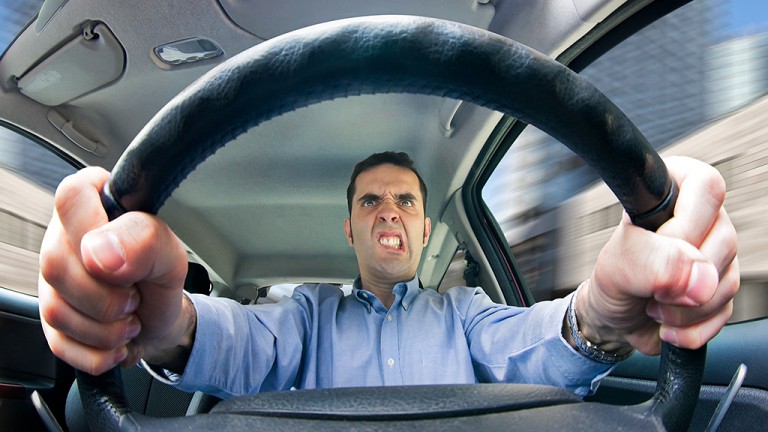
Rules for driving on a tachograph
In order to learn how to properly drive on the tachograph, the driver must fully study the instructions from the device. Explain to yourself the whole process of his work. The article indicates how to handle such devices. You always also keep your way, as if there is no device. It's just recording and recording the speed of your movement. This is some control, under which the driver must adjust. Compliance with all safety requirements and regulations traffic the driver will not be hindered by such an assistant, a controller, as a tachograph in a car.
How to use the digital tachograph
It is now easy to follow how to use the tachograph correctly, according to its principle of operation, the information is accessible and simple.
Here is the whole principle of the device:
- Printing device.
- Screen.
- Tachograph card receiver.
Outwardly, this device resembles a radio tape recorder. And depending on the component parts, the characteristics may increase.

Here are the advantages of the tachograph and all the tasks that it can easily solve:
- - legal protection of the driver;
- - transportation is free in foreign countries;
- - the possibility of an unauthorized trip is completely excluded;
- - Significant increase in safety;
- - grade professional qualities driver using the device;
- - increasing the resources of tires, brake systems, engine.
It has also been proven by professionals that driving on tachographs can provide not only protection for the driver with a tachograph, but also avoid getting into an accident involving a truck. Since the system always controls not only top speed movement, but also the time when you need to change the driver. And a tired driver, a driver who is prone to sleep on the road while the car is moving, is a potential culprit in an accident.
Most drivers have already voted for the use of tachographs, there are fewer accidents with them, why not use it in every car. As a hint to drivers about the duration of the journey and the requirement to limit the speed of movement in their own car. Correct use tachograph is always the way to successful and safe transportation.
The requirement for the mandatory presence of tachographs in Russia was introduced gradually:
- from April 1, 2014, all freight vehicles carrying dangerous goods must be equipped with them;
- from July 1 of the same year - passenger buses of category M1 and M2, carrying out intercity and international flights, as well as trucks over 15 tons;
- from September 1 - trucks from 12 to 15 tons;
- and finally, from April 1, 2015 - trucks weighing from 3.5 tons.
To date, the use of 3 types of tachographs is allowed:
- analog;
- digital, corresponding to the European AETR standard;
- digital with the CIPF block (means of cryptographic protection of information).
It should be noted that from January 1, 2018, the use of analog tachographs is not allowed.
Starting from 2018, for all passenger and freight commercial vehicles that move around the territory of Russia and beyond its borders, it is necessary to install:
- digital tachographs AESTR - for organizations that have licenses for international transportation;
- digital tachographs with a CIPF block - exclusively for domestic transportation (vehicles on which a tachograph with CIPF is installed are prohibited from traveling outside the Russian Federation - even to Belarus or Kazakhstan).
It's pretty expensive device. Domestic samples with CIPF cost in the range of 30-40 thousand, plus add to this the installation (10 thousand), (from 3 thousand), the manager's card, calibration (carried out every two years), replacement of the CIPF module (once every three years ). AETRs are cheaper, but you also have to pay a lot of money for calibration, cards, etc.
How to use digital tachograph?
If you go to the website of Rosavtotrans, then you can find a list of models that can officially be installed on a vehicle. In this list, we see both Russian samples - Shtrikh TAHO-Rus, Casby DT-20M, Mercury TA-001, etc. - and foreign-made ones: StoneRidge SE5000 Exakt, Efkon EFAS-4, Continental VDO and others.
There is no fundamental difference which model you have installed - with a cryptographic information protection module or corresponding to EU standards. They differ from each other only in the hardware part - CIPF. Accordingly, in order to learn how to use this device, it is enough to know the basic rules.
Please also note that the management of the company must conduct a minimum educational program and issue a user manual to each driver.
Getting started, the driver inserts a personalized card into the first slot with the chip up until it clicks and enters the PIN code. The greeting and full name appear on the display. driver. If the driver is with a partner, then the partner card is inserted into the second slot.
Then you need to set the date and time, as well as manually enter the point of departure. The tachograph can also ask what the driver has been doing since the last time the card was removed from the slot. In this case, you need to select the appropriate icon - repair work, rest.
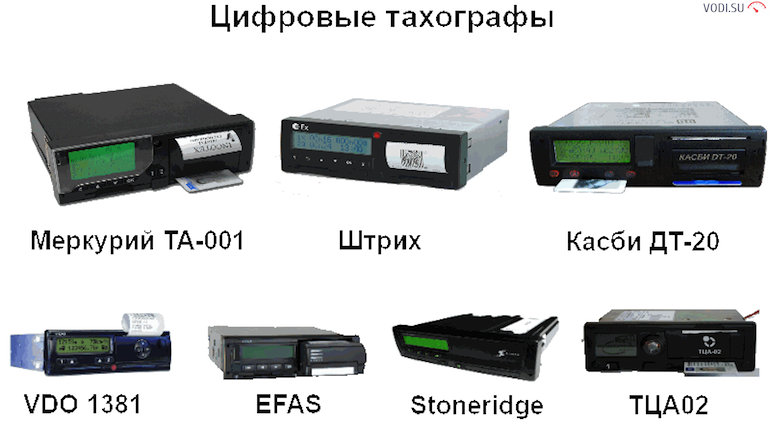
As soon as the driver starts moving, the recording of movement data begins - the “Steering wheel” icon appears. Digital tachographs usually automatically display the current status, for example, if you had to stop on the highway, the “Stop” mode automatically turns on. If the ignition is turned off, the “Bed” icon is displayed, that is, rest.
At the end of your shift, you need to get the card using the Eject key. If a partner gets behind the wheel, the cards are reversed. Recall that the driver can be behind the wheel no more than nine hours a day. It is also allowed to work 10 hours two days a week. Every 4.5 hours you need to make one rest stop for at least 45 minutes. No more than 2 times a month it is allowed to drive for 15 hours.
Inspectors, endowed with appropriate powers and a controller card, have the right to stop freight transport and check whether the driver complied with the sleep and rest regimen.
The inspector must present:
- a plate with settings - pasted on the door on the driver's side (it indicates: the address of the workshop, tire size,);
- the control device itself - the inspector will check the integrity of the seals;
- printout of tachograph readings.
In addition, the inspector can insert his controller card into the slot and reset the tachograph data to an external drive. The driver should always have the printer loaded with a roll of thermal paper, and you should also carry spare rolls with you. The printout shows the hours of work and rest. Separately print out data on high-speed mode. The inspector may require information to be printed on the "Incidents and Errors" request to determine if the device is operating correctly.
To make a printout, the driver must select the start date on the display, select the "Print" menu item and press OK. In addition, the driver must be able to insert the thermal paper roll into the printer of the control device by himself.
The company monitors the health of the devices. Only certified workshops have the right to carry out maintenance, each master has his own workshop card.
As you can see, the introduction of digital tachographs is a useful thing, especially for regulatory authorities and owners motor transport enterprise- they will be able to check all the information about the movement of the car. For ordinary truckers, this is another headache.
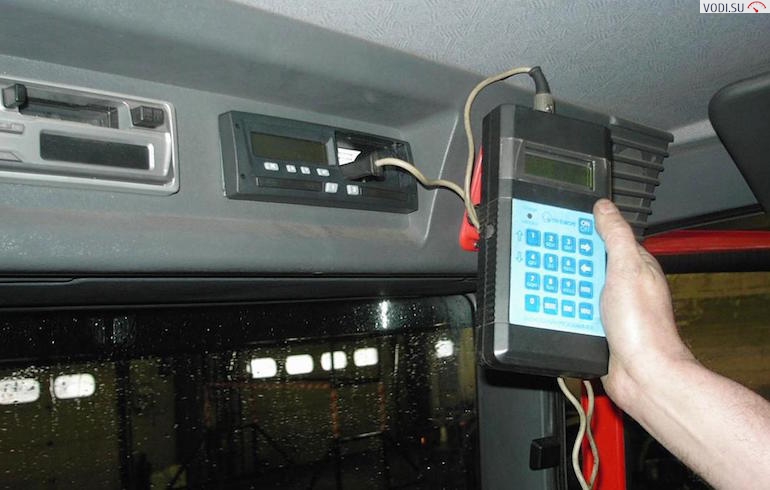
By the way, the editors of the portal site have already mentioned about. Be sure to check them out.
How to use an analog tachograph (tachograph)?
A tachograph with a washer is much easier to use.
There are only two types:
- in the form of a speedometer;
- in the form of a car radio.
Both types are associated with the gearbox and speed sensor. All information is displayed on the scoreboard and on a paper disk that is inserted into the slots. If there are two drivers, then there is a separating cover for installing a second washer.
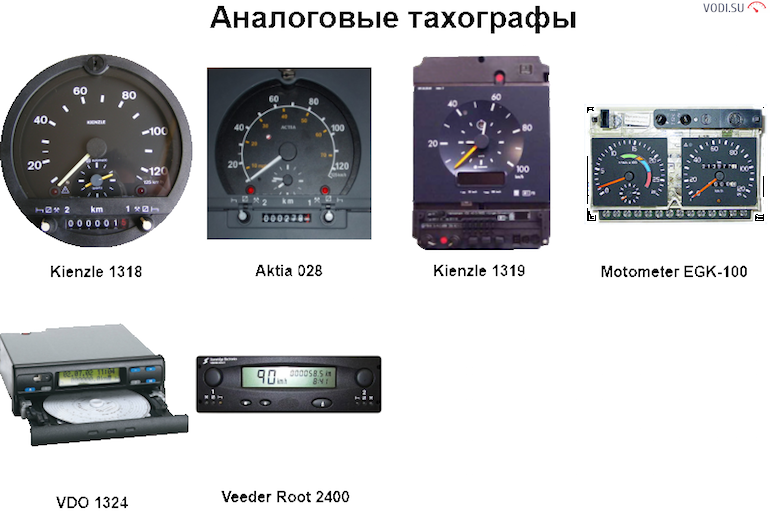
The disk before starting work is filled by hand:
- Full name, date and time of card installation;
- the name of the starting point of the route;
- mileage on the speedometer;
- license plate of the car.
Accordingly, at the end of the working day, the mileage traveled per day, the final destination of the route, the date and time of card extraction are indicated. One disk is installed for one day of work, even if the car has been on the road for several hours.

Here, as in digital models, pictograms are used, and switches are installed on both sides of the dial for each driver:
- driving - steering wheel (switches while driving);
- rest - crib (with the ignition off);
- work mode - hammers (remains on both when driving and when carrying out any repair work);
- being at the workplace - a crossed-out square (set when a partner is driving).
When a partner gets behind the wheel, the tach washers are reversed.
The requirements for the installation of tachographs on a number of vehicles have been in force for quite a long time. For the absence of such devices, a fine is due, as well as for a violation.
In addition, for any interference in his work, you will also have to pay with a "ruble". Let's consider this series of questions in more detail.
Tachograph and law
Orders of the Ministry of Transport of the Russian Federation No. 273 dated August 13, 2013 (text) and No. 470 dated December 17, 2013 (text) prescribe the installation of tachographs (with a cryptographic information protection system - CIPF) on the following categories of vehicles:
- All vehicles carrying dangerous goods;
- M2 - vehicles with a permit maximum weight up to 5 tons and more than 8 passenger seats;
- M3 - vehicles with a maximum mass of more than 5 tons, intended for the carriage of passengers;
- N2- trucks, with a permitted maximum weight of 3.5 tons, up to 12;
- N3 - trucks with a maximum authorized mass of more than 12 tons.
At the beginning of 2015, all vehicles carrying dangerous goods, buses and trucks with a mass of 12 tons or more should be equipped with such devices.
At the same time, if an old-style tachograph (without cryptoprotection) was already installed on the vehicle before February 28, 2014, then its use is allowed until January 1, 2018.
It is also allowed to use vehicles with tachographs that comply with EU standards installed during production (if the vehicle was manufactured before April 1, 2014).
The need to install crypto-protected tachographs on trucks of category N2 with a mass of 3.5 to 12 tons used for the transport of goods that are not classified as dangerous comes from April 1, 2015.
Video - about the use of tachographs from April 1, 2015:
Installing the instrument
You cannot install a tachograph yourself. They can only be installed by workshops that have the appropriate permission (issued by the Ministry of Transport, more precisely FBU Rosavtotrans). Each workshop has its own sealing, to which all installed devices and critical connections are subjected. Users must not break seals.
The technology and model of the tachograph itself depends on the specific brand of car.
Electronic cards will also be required, both for the driver and for the company. Such cards are issued by only two organizations - RusTAHONET LLC and RusAvtokart LLC.
The process of obtaining tachograph cards can take up to two weeks which must be taken into account before operation. Using the vehicle without a driver card (the company card is only used to access tachograph data) will be punished with an administrative fine (misuse).
Tachograph fine
The tachograph takes into account driver's work and rest time, which must comply with the Order of the Ministry of Transport No. 15 of 08/20/2004 (text).
This normative document establishes a framework for working hours - no more than 40 hours a week, with some exceptions.
In addition, periods of work and rest are normalized - at least 42 hours a week, while rest must both precede the trip and follow it.
Penalty for the absence of a tachograph and violation of the work and rest regime of the driver
Administrative punishment will follow in accordance with Art. 11.23 of the Code of Administrative Offenses of the Russian Federation, if the vehicle (suitable for the mandatory installation of a tachograph) does not have a device of the appropriate type, or the vehicle was released onto the line with an inoperative tachograph: a fine from 1 to 3 thousand rubles for citizens, and for officials— from 5 to 10 thousand rubles.
In case of violation by the driver of the regime of work and rest - the fine will be from 1 to 3 thousand rubles.
Excerpt from the Code of Administrative Offenses:
“Article 11.23. Driving a vehicle or launching a vehicle for the carriage of goods and (or) passengers without technical means control, violation by a person driving a vehicle for the carriage of goods and (or) passengers, the regime of work and rest
1. Driving a vehicle or launching a vehicle for the carriage of goods and (or) passengers without a technical means of control that provides continuous, uncorrected registration of information about the speed and route of the vehicle, about the mode of work and rest of the driver of the vehicle (hereinafter referred to as the tachograph ), if its installation on the vehicle is provided for by law Russian Federation, as well as with a non-working (blocked, modified or faulty) or with an inappropriate established requirements tachograph, except for the case of a breakdown of the tachograph after it was released onto the vehicle line, as well as with a violation established rules use of a tachograph (including blocking, correcting, modifying or falsifying the information it registers) - shall entail the imposition of an administrative fine on citizens in the amount of one thousand to three thousand roubles; for officials - from five thousand to ten thousand rubles.
2. Violation by a person driving a vehicle for the carriage of goods and (or) passengers of the established regime of work and rest - entails the imposition of an administrative fine in from one thousand to three thousand rubles.»
Fine for a faulty tachograph
It is possible that the tachograph failed after entering the vehicle line, while all the seals on the critical components of the device are intact. Those. the breakdown occurred without "outside help".
In this case, the driver must return to his garage in order to repair the tachograph with the involvement of specialists from a company authorized to carry out such work.
Operation of the vehicle with an inoperative tachograph is prohibited, as indicated by paragraph 7.4 of the list of faults in which the operation of the vehicle is prohibited:
"The list establishes malfunctions of cars, buses, road trains, trailers, motorcycles, mopeds, tractors, other self-propelled machines and conditions, under which their use is prohibited.:
…7.4. The body or cabin door locks provided for by the design, the locks of the sides of the cargo platform, the locks of the necks of tanks and the plugs of the fuel tanks, the mechanism for adjusting the position of the driver's seat, the emergency door switch and the stop request signal on the bus, instruments indoor lighting of the bus interior, emergency exits and devices for actuating them, door control drive, speedometer, tachograph, anti-theft devices, devices for heating and blowing glass.
In such cases, for a faulty tachograph in accordance with paragraph 1 of Art. 12.5 of the Code of Administrative Offenses of the Russian Federation provides for a warning or a fine of 500 rubles.
“Article 12.5. Driving a vehicle in the presence of malfunctions or conditions under which the operation of vehicles is prohibited
1. Driving a vehicle in the presence of malfunctions or conditions under which, in accordance with the Basic Provisions for the admission of vehicles to operation and the duties of officials to ensure road safety, the operation of the vehicle is prohibited, with the exception of malfunctions and conditions specified in parts 2 - 7 of this article - entails warning or imposition of an administrative fine in the amount of five hundred rubles.»
Video - who is obliged to install a tachograph on a vehicle and what is the responsibility for their absence:
Instrument operation and data storage
The tachograph records data not only in its own memory, but also on the driver card. Data must be downloaded from the driver card every 28 days, and from the device memory every 90.
Data from the device is uploaded to a computer and must be stored for 1 year, moreover, be available for possible verification. The driver, if it is impossible to download data from the card, can print them out using a tachograph and have them with him.
Failure to comply with these requirements threatens with fines similar to those for the absence of a tachograph and the operation of a vehicle with a faulty tachograph.
How to cheat the tachograph and should it be done?
It is strongly not recommended to try to deceive the tachograph. Even its power, without urgent need, should not be turned off. The system is made in such a way that it is almost impossible to deceive him (as well as correcting his testimony). All abnormal situations are recorded in the module with cryptoprotection.
The relevant employee always learns about all periods of power failure of the device, about any violations of the electrical circuits of communication with the sensors (if your own sensor is used, which, by the way, is sealed) and the discrepancy between the mileage according to the device data and the ECM data (on modern cars, the tachograph is connected to the control system , which record mileage and speed, as well as other parameters).
Even if you turn off the power supply of the device and communication with the ECM, after switching on, an abnormal situation about data discrepancy will be recorded in the memory.
Trying to disable the device by applying too much voltage is also useless. The tachograph has built-in power line protection. Even if, theoretically, it is disabled, the data will still be saved, because. used components from high level protection (even from radiation).
For older non-ECM equipped vehicles, separate sensors are installed. It is also almost impossible to deceive them. Data transmission is carried out digitally, with data stream encryption and integrity control.
Moreover, each sensor is "tied" to its own tachograph and calibrated in the workshop where the device was installed. Besides, everything important connections are sealed, and the facts of violation of communication are recorded.
It is also useless to play around with magnets - the equipment is made according to "military standards" and is not afraid even of EMP from a nuclear explosion.
Hopes to correct the memory of the device can also be left - safety standards have been developed by the FSB. Not every special service will be able to open a protected module, not to mention homegrown young hackers, and it will take an unacceptably long time (due to the need to unload the fact will be visible).
One more important point– the CIPF unit is equipped with a navigation module. According to the data from it (time, speed, fact of movement and other data are determined from the satellite), all parameters of the vehicle's movement are easily determined.
If they do not match the data of other systems (hours, speed, mileage), then this will also be displayed in the non-volatile encrypted area of the device's memory.
In the end, everything misconduct will not only not lead to the desired result, but are also likely to cause financial losses (possible as administrative penalties, and the need to contact the workshop for correction or re-checking).
Pros and cons of using such a meter
The government, by introducing tachographs, seeks to reduce accidents on the roads, forcing drivers to comply with traffic rules and the regime of work and rest for drivers. The effectiveness of this method has been proven in European countries, from where the experience was adopted.
How effective it will be in the conditions of our country - time will tell.
In addition, it should be noted that additional financial flows from imposed fines and tax revenues from the total economic activity infrastructure maintenance companies.
There are also positive aspects for a conscientious driver - the employer will not be able to "demand the impossible." You can safely do your job, resting on time and without violating the rules of the road.
Employers can also come in handy with a metering device - this will help get rid of unscrupulous drivers. After all, the facts, for example, the drain of fuel, will be quite simple to establish. As well as interference in the control system - it is enough to ask some questions, for what purpose this or that block is “affected”. Yes, and "left" transportation will also be recorded.
But unscrupulous drivers will have a hard time. It will be necessary either to spend a lot of financial resources on fines, constantly changing jobs, or to retrain as conscientious ones.
Among the minuses there is one, but quite serious - additional financial costs. You will have to equip vehicles with not the cheapest equipment, as well as pay for its maintenance. But against the general background, these costs are not so significant, especially if the "pluses" become significant.
Liquid glass will help protect the car from dirt
3 in 1: DVR + GPS informer + radar detector
How to protect yourself from the blinding sun and headlights while driving?
The tachograph is installed in the vehicle to be able to control the work and rest of the crew, as well as to monitor compliance with speed limit. Every commercial vehicle driver should know how to use a tachograph.
Tachograph device
The tachograph is a small device that looks like either a radio tape recorder or a speedometer if the tachometer is round. Its main task is to fix the operation of the engine and the speed of movement. Control is carried out primarily in the interests of the transport crew, as well as for general security all participants in the movement. If the tachograph is mechanical, then all data is recorded on film, if digital, then on a memory card.
By Russian legislation digital tachographs are mandatory for use, since falsification of data from such devices is almost impossible. Only certain employees of the enterprise should have access to reading information.
The device consists of the following parts:
- control panel with display - for the possibility of setting up and monitoring the device;
- printing device - works on the principle cash receipt, displaying data on thermal tape;
- tachograph card reader - for driver identification;
- GPRS modem - for transferring information to the server;
- motion sensor - data is transmitted from it in encrypted form, which completely eliminates the possibility of falsification;
- seals for the odometer, clock and constant switch.
A receiver of global positioning signals is mounted inside the device, in Russia it is the GLONASS system. To connect the flight recorder, a regular car electrical wiring is sufficient. All measurements are carried out by the tachometer's own sensors, regardless of the readings of the vehicle's instruments.
Tachograph card
The card is needed to be able to identify the driver of the vehicle, as well as to read information from the device by regulatory authorities. All cards are equipped with a special microchip - to exclude the possibility of forgery. Cards are of the following types:
- driver card - for identification;
- master card - needed to install and configure the device;
- company card - for receiving and evaluating tachograph data;
- controller card - for taking testimony by traffic police and other regulatory authorities;
The driver is not allowed to use someone else's card. Before starting to move along the route, he inserts the card into the tachograph, after which it remains there until the vehicle returns to the base. If there are two drivers, the second card is inserted into the second slot and the second driver enters his pin code. The validity of the card is limited.
In addition, according to Russian legislation, if a vehicle has a tachograph, instructions must be attached to it without fail. In the absence of operating instructions, the traffic police inspector has the right to issue a fine.
Analog tachograph
When operating an analog device, a special chart disk is used - a washer, which must be filled correctly.
Before inserting the puck into the tachograph, the driver fills in the following data:
- departure point;
- departure date;
- state number of the vehicle;
- initial odometer readings;
The driver starts work according to the schedule. At the end of the work shift, the washer should be removed and manually filled in with the following information:
- place of arrival (settlement);
- end date of the work shift;
- final odometer readings;
- total mileage traveled per shift.
The filled washer must be kept by the driver for at least 28 days.
Procedure
- Before leaving for the route, the driver card is inserted into a special opening with the chip up, after which a PIN code request is displayed on the screen. If the PIN code is entered incorrectly more than three times, the card is automatically blocked. To unlock it, a puk code is used, which comes with a pin code. If the card and pin code are entered correctly, the display should show the name of the owner.
- Next, data on the location of the driver before the start of the work shift is entered: the “rest” mode or the “work” mode. After the data is entered, the driver can start moving. From now on, the display will automatically show the driver's activity mode.
- When the ignition is turned off, the tachograph automatically switches to the “rest” mode, or the driver himself switches it by pressing the corresponding key. When the engine is off, the flight recorder displays the rest mode. If the engine is running, regardless of whether the car is moving or standing still, the tachograph records the “work” mode. All data can be viewed by the driver on the display.
- At the end of the work shift, the driver removes the card from the slot.
Reading the testimony
The tachograph must be filled with special thermal paper for printing readings. The absence of thermal paper is tantamount to a breakdown of the device, so the driver must carry at least two spare rolls with him. The procedure for printing readings will be as follows:
- You must enter the main menu and select the "print" action.
- Next, you should select the data that you want to print - it can be data either for the driver or for the car.
The driver of the vehicle must know how the recorder data is printed, how the thermal tape is replaced, and also monitor the availability of paper for the thermal printer.
In the event of a breakdown of the flight recorder, the driver is obliged to enter all the data on the tachograph tapes manually, putting his personal signature. These actions are mandatory for further analysis of the driver's work and rest regime. The device must be repaired within 7 days, otherwise the driver will be fined.
Correct operation of the tachograph primarily protects the driver from unnecessary fines and reduces the risk of an accident.
By the nature of their activities, almost all motorists are faced with a huge number of auxiliary equipment such as a tachograph. However, when purchasing certain devices, they often have no idea how exactly the equipment for motorists works. We decided to correct this situation and tell you in more detail about how to use the tachograph.
What it is?
The tachograph is a small mobile device that processes certain electrical impulses that come from. At the same time, signals are sent when the car is moving. Generally speaking, the tachograph acts as a kind of latch that controls the speed at which the car is moving at one time or another. It is also capable of trapping and fixing the owner of the vehicle. This is a kind of flight recorder.
What are the devices
Before answering the main question, how to use a tachograph, it is necessary to clarify what this equipment is like. As a rule, devices are distinguished round and radio format. In this case, round-shaped tachographs are usually attached directly to the main hole of the speedometer. Devices with a radio format are installed in the "nest" of the car radio.
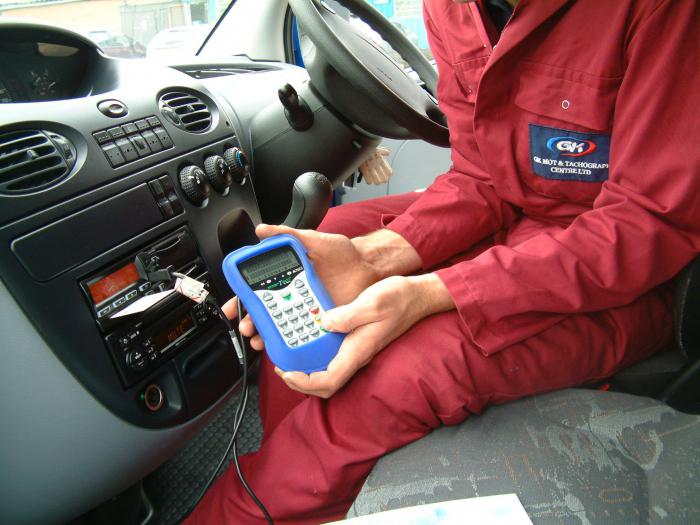
If we talk about the types of tachographs, then there are analog, or electronic-mechanical, as well as digital.
What is an analog recorder
Externally, such a system has common features both the radio and the speedometer. It has a round dial with a clock and a speedometer. If you do not know how to use the tachograph correctly, we will help you with this. In this case, if you decide to purchase an analog type device, then you need to know what data is on the equipment. So, on the front panel of the device is the following information:
- the current speed of the machine;
- elapsed time and distance of the car;
- device operating modes;
- indicators for determining the fact used to set the chart disk;
- operating mode switches for the first and second driver.
What do the light signals on the recorder say?
From the bottom of the device have a special backlight or signals light type. Moreover, the signaling device, located on the left, is able to give signals not only when the cover on the front panel is not closed, but also in the event of a detected equipment malfunction. The sensor, located on the right side, lights up if the driver exceeds the set speed limit. This is how an analog tachograph works. How to use it, we will tell further.

General features of digital tachographs
Digital models are considered a real breakthrough in the entire history of the production of these devices. They are more perfect and relevant than others. What is so remarkable about them? This equipment has high precision protective system, which is an excellent prevention of unauthorized entry and manipulation of the device.
Digital tachographs usually work in conjunction with a driver card. It is thanks to this that the device allows not only to record the downtime and movements of the driver, but also to store this information in the memory of the equipment. By the way, if for some reason one of the dishonest motorists wants to hack or bypass the system, then this information will also be recorded on the map. We will describe below how to use the digital tachograph.
In addition, information about the driver's activities stored in the memory can not only be viewed, but even printed. To do this, the data is transferred to a special database, downloaded and printed using a printer.
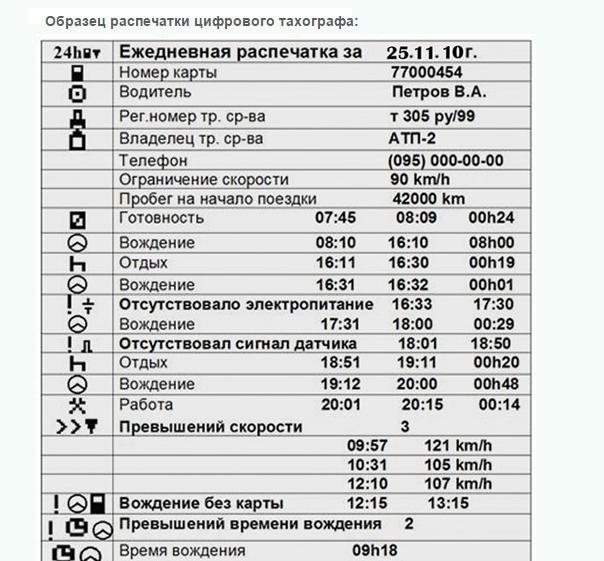
The device itself has speedometer and clock options. It is equipped with a pair of slots used as compartments for the display and cards, and is usually connected using a protective sensor to the gearbox.
What cards are used to work with a digital tachograph
For the full operation of the device, you must use the following types of cards:
- inspector;
- car owner;
- organization card (the operator of cargo transportation is fixed in it);
- map of the calibration center or workshop.
And of course, before using the tachograph, the driver needs to know what rights the owners of these cards have. In this case, both the driver and the inspector, and other authorized persons can access the device's memory card at the right time, and then view or download information for a specific period of time.
What are digital tachographs
Digital devices may comply Russian rules security dated September 10, 2009 (this applies to a greater extent to domestic brands of production). At the same time, this equipment is used in tandem with Russian cards.

Also, digital devices can be imported and comply with European safety regulations. To a greater extent, such tachographs are used to control the operation of vehicles that often make international flights. And, of course, only European cards are suitable for these devices. This is what all those drivers who do not know how to use the tachograph need to remember.
How to work with an analog tachograph
For example, you were lucky enough to purchase an analog tachograph. What to do next? To begin with, it is recommended to carefully study the instructions, and then inspect the chart disks of the device and compare their models for matching with the model of the product itself.
In the next step, you will need to hand-paint the clean side of the aforementioned disc, located in its inner part. It is simply referred to as a tachoshiba. It is removable and after filling is inserted back into How to use the tachograph with a washer?
Pay attention to the center of the disk and the blank columns, in front of which certain icons are set. So, for example, in front of a semicircle with a flat top, resembling the driver's head, you must specify the full name. car owner. Near the dot with an arrow showing the direction to the right, it is necessary to note the exact name of the place (in terms of geography) in which the technical map was installed. Etc.
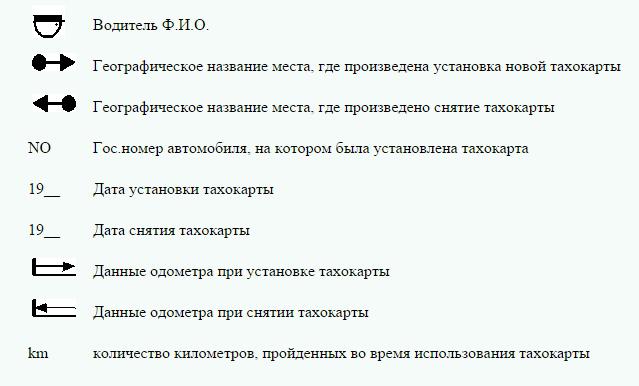
If you have filled in all the required fields, we will answer the question of how to use the tachograph further. Let's start with the fact that all other fields and zones on the device disk are filled in automatically when the motorist moves, works or rests. Therefore, there is no need to enter data there.
For example, if the car first drove and then stopped, then on the disk you will see broken lines going up and then down. They are similar to a cardiogram, which is transformed into a continuous straight line that runs along the entire circumference. At the same time, 1 mm of such an endless line is equivalent to 1 km of rally. The distance between the subsequent circle of data is 0.5 mm, which corresponds to 0.5 km of rally.
Installation process
For the device to work in in full, you need to insert a tacho washer into it. To do this, open the cover panel located on the front of the device and carefully insert the disc into the slots. Slide it in and securely close your panel cover. Then put on the panel an icon such as two crossed hammers, which will indicate the beginning of your work.
In the process of driving, your device will automatically switch to a mode that indicates the start of driving and is displayed as a circle with a dot in the middle (this is a kind of steering wheel image). If, in the process of driving, the driver decides to stop and rest, then he needs to switch the device to the appropriate position (the pointer should be turned towards the icon that looks like an inverted letter "h" or a high chair). Unfortunately, not many people know how to use a tachograph card.

If the driver starts moving after a rest, then he needs to switch back to hammer mode. If a second driver is involved in the operation of vehicles, then from the moment of his work the first tach washer is removed and replaced by the second. Now the whole procedure of work, movement and rest will be repeated, as in the first case.
How to use a tachograph with a chip
The digital device usually works in conjunction with a driver card equipped with a chip. On it, in turn, all the necessary data about the driver are indicated. In order to enable similar device, you must first insert this card. Don't forget to turn its electronic chip up first. In this case, the card must be inserted all the way, in confirmation of which you will hear a dull click. If everything is done correctly, you can see the contacts of the cardholder on the monitor screen.
Next, you need to specify the coordinates of the place, country and city where the driver's car is located at the time the device is launched. The main advantage of such equipment is the minimization of manual adjustment. All operations, including recording the rest or work of the driver, are performed automatically. And the mode set by the device can be seen on the monitor screen. At the end of the shift, the driver must remove his card from the device and turn off the equipment.
What you need to know about the driver card
The driver's card is a unique document capable of storing information about the movement and work of the driver for 28 days from the date of its activation in the tachograph. Inspectors and traffic police representatives have the right to receive data from the card. It is they who can inquire about the activities of the car owner over the past 28 days.





